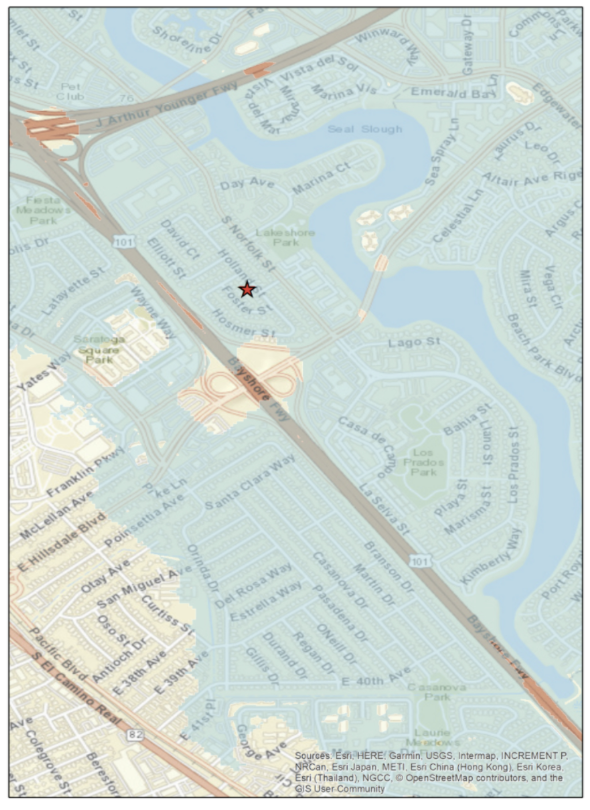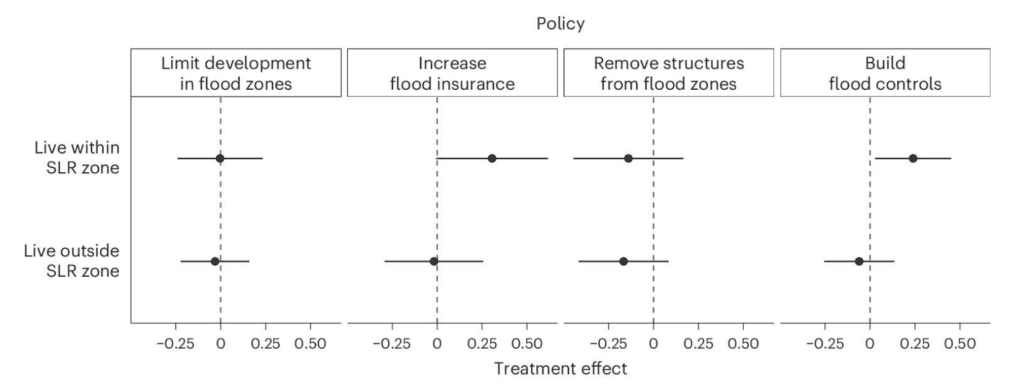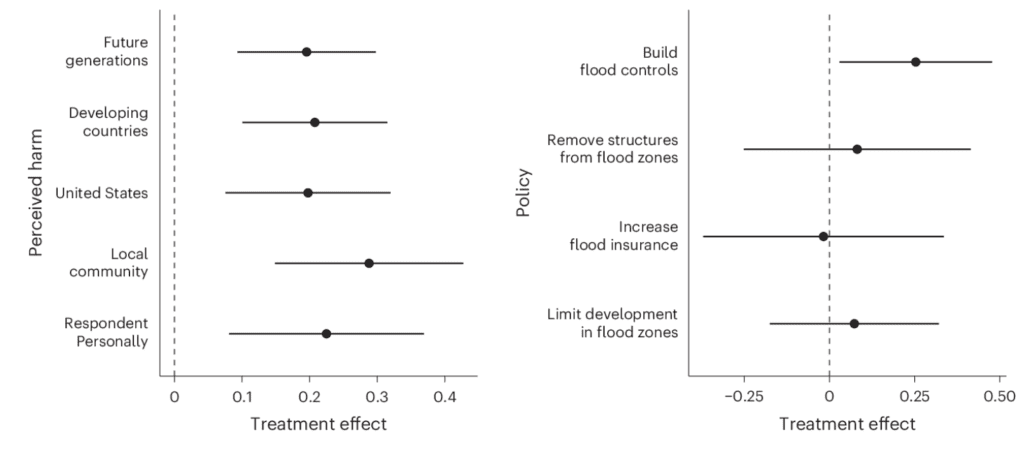Peer-Reviewed Article · Oct 31, 2024
Sea-level rise maps can decrease risk perceptions in coastal communities
By Matto Mildenberger, Jennifer Marlon, Alexander Sahn, Michelle A. Hummel, Chris Miljanich and Mark Lubell
Filed under: Behaviors & Actions, Climate Impacts and Messaging

We are pleased to announce the publication of a new article, “Unintended consequences of using maps to communicate sea-level rise” in the journal Nature Sustainability.
Key Findings:
- Flood maps can backfire: Coastal residents, even those facing future flooding, can become less concerned when shown sea-level rise projections for the distant future.
- Coastal residents became more worried about flood risks when told how sea-level rise will affect their daily commute.
- Test before scaling: Risk communicators should test different data visualization strategies before launching climate communication campaigns.
Sea-level rise (SLR) caused by climate change poses enormous social and economic risks to coastal communities around the world. By 2100, hundreds of millions of people in coastal communities will be impacted by sea level rise. However, coastal residents, real estate developers, and municipalities often remain stuck in a dangerous mindset of “rebuild at all costs” – even in areas at extremely high risk of repeated, worsening floods. One strategy commonly used to raise public awareness and motivate local action is to share maps of projected local flooding. This strategy, however, may ignore important psychological and behavioral factors that influence how individuals respond to risk communication. 
Fig. 1. Example of a map that was shown to survey participants in the treatment group.
To test the effectiveness of maps depicting potential future flooding due to sea level rise (SLR), we studied residents living near projected SLR boundaries (areas that are projected to flood by 2100) across four coastal areas (San Francisco Bay Area, California; Palm Beach County, Florida; Norfolk, Virginia; and Ocean County, New Jersey). Respondents either viewed an aerial map that showed projected flooding in their census tract, with their individual house address highlighted, or continued the survey without seeing any map. For all households, we asked questions about their perceived risk of flooding and attitudes toward climate adaptation policies. For a California sample, we also separately provided respondents with information about increases in commute traffic due to SLR-affected infrastructure.
Sea-level rise maps reduced concern about personal impacts
Overall, we found that Americans living in coastal communities primarily view SLR as a problem for other communities and publics – not their own – even when their own properties were portrayed as permanently inundated by the end of this century. Additionally, we found that showing respondents a map of projected sea-level rise backfired. When residents in coastal areas were shown maps of projected flooding in their neighborhood, this actually reduced concern about impacts on their properties – even when those properties were projected to flood by 2100.
Among individuals located just outside projected SLR boundaries, map exposure decreased perceived personal harm by 0.50 points on a 4-point scale (equivalent to 0.58 standard deviations (s.d.), P < 0.01). While this may be expected with maps showing a respondent’s property just outside of direct flooding danger, we also find a similar reduction in personal concern among respondents who would be inside the flooded areas in the future. Among respondents whose maps explicitly marked their addresses as within the SLR zone, we found perceived levels of personal harm decreasing by 0.33 on a 4-point scale (0.37 s.d., P = 0.03). Furthermore, maps did not significantly change perceptions of harm to the local community, or to more distant groups or future generations.
Sea-level rise maps increased support for collective management
Even while sea-level rise maps reduced risk perceptions, we found that exposure to these maps increased support for some adaptation policies. Residents within SLR flood zones were more likely to support increased flood insurance and more flood-control infrastructure, but there was no increase in support for more costly adaptation strategies, such as limiting development in flood zones or building flood controls. Respondents whose homes are not projected to flood had unchanged preferences across all measures, despite their reduced personal concern.
Fig. 2. Study participants who saw a map that portrayed their property as permanently inundated in the future were more likely to support increasing flood insurance and building flood controls than were those whose homes were projected to be outside the SLR zone.
Information about projected traffic delays increased concern about SLR
If high-resolution spatial maps of risk exposure do not meaningfully increase respondent concern about SLR risk, how might policymakers better increase support for adaptive behaviours? We found that receiving information about traffic commutes increased perceived harms from SLR by 0.23 points on a 4-point scale (0.22 s.d., P < 0.01). Unlike the map treatment, providing information about SLR’s effect on traffic commutes increased perceived harms both personally and for distant groups, even though the experiment still presented information about future risks anchored around the same date (2100). Like the map treatment, the traffic treatment shifted respondents’ views on policy remedies for SLR, but only for building flood controls (b = 0.215, P = 0.01). Unlike the map treatments, there were no effects on policy to increase the take-up of flood insurance.
Fig. 3. Study participants who received additional information about how flooding would affect traffic and their commute times were more likely to perceive flooding as harmful to all groups of people and also to support the construction of flood controls (but not flood insurance).
Key Takeaways
Contrary to policymaking goals and advocates’ expectations, providing risk-exposed coastal residents with maps of projected sea-level rise was found to reduce individual concern. By contrast, emphasizing infrastructure disruptions in the form of increased commute times increased concern among all coastal residents.
Overall, our results speak to the critical need to empirically test public climate communication campaigns to ensure that targeted interventions encourage risk perceptions and behavioral intentions in support of climate adaptation policies. Our findings have important implications for risk communication practices. Our experiments offer a high-resolution test of a commonly used real-world strategy to communicate climate risks. Practitioners, government officials and activists should consider the limits of individualized communication about SLR as a method to build support for policy.

